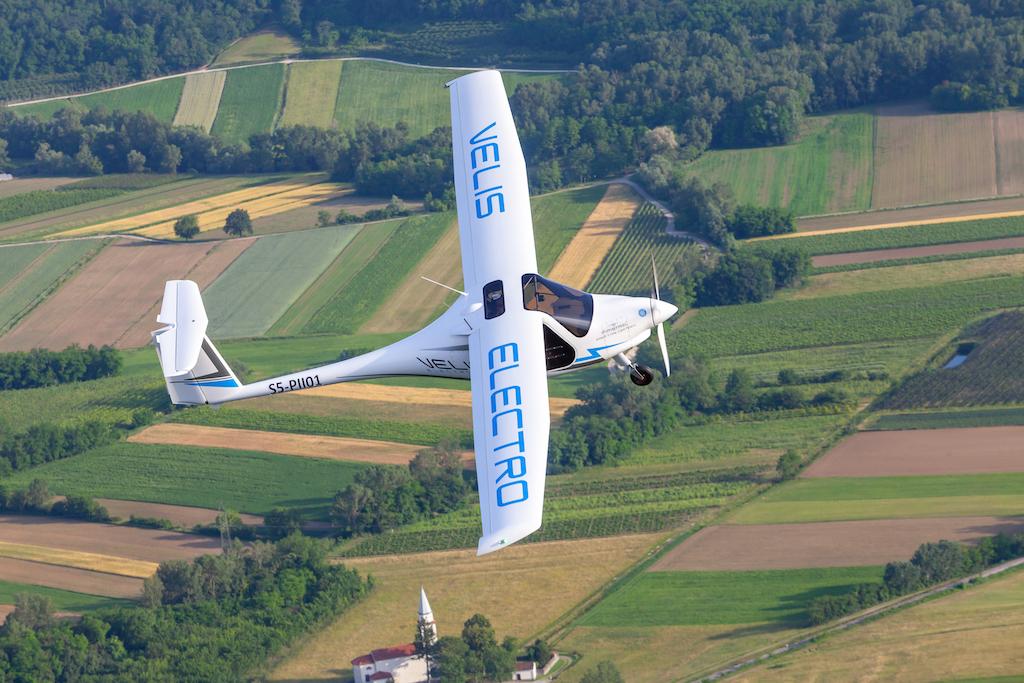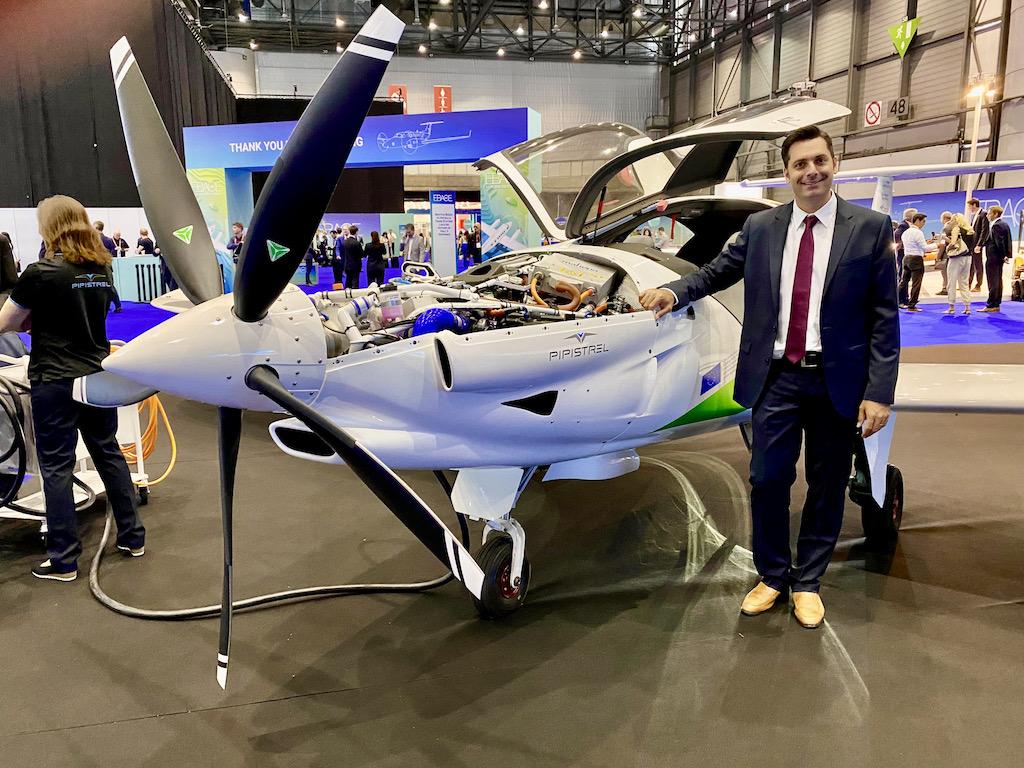
The electric-powered Pipistrel Velis Electro was type certified by EASA in June 2020.
Pipistrel’s engineering knowledge of electric propulsion dates to before 2007. It has two-plus generations of considerable in-house R&D experience, and its team has already won multiple awards.
The electric drivetrain is just one of the engineering specialties within the Pipistrel team to produce an efficient aircraft. This team evaluated propeller efficiency by analyzing two existing propellers during ascents and descents, and comparing the number of traffic pattern circuits performed with one fully charged battery. When a propeller designed for piston engines was replaced with a propeller tailored to electric drive, the net energy consumption within ascent and descent was decreased by 19%. Similarly, a 27% increase in the number of traffic pattern circuits (endurance) was achieved.
In 30 years of activity, Pipistrel has proven its expertise in working with metal and composite materials. The majority of the Velis Electro’s structure is made from carbon-fiber composites. Composite construction is superior to achieve the surface shapes necessary for efficient aerodynamics. Composite structures have further advantages in corrosion resistance and fatigue resilience. They also allow engineers to build strong structures at the lightest possible weights. Pipistrel’s in-house prototyping facility offers one of the largest eight-axis robots in Slovenia for milling, a five-axis waterjet cutter, 3-D printers and scanners with a wide selection of computer numerical control (CNC) machines.
International Awards

The Pipistrel team has been recognized with noteworthy international accolades and awards for its accomplishments in sustainable aviation. In 2011, NASA launched a competition with a $1.3 million prize to develop an electric-powered aircraft capable of flying 200 mi. in less than 1 hr. using the energy equivalent of 1 gal. of fuel per passenger. The innovative winning aircraft, Pipistrel’s Taurus G4, featured a twin-fuselage concept with a large central wing housing the most-powerful electric aviation motor ever developed (145 kW) at the time. The minimum efficiency criteria figure—in passenger miles per gallon (pmpg)—was 200, but Pipistrel won the competition by totaling 403 pmpg. This impressive recognition illustrates that out-of-the-box thinking can set new performance milestones previously thought impossible.
The American Institute of Aeronautics and Astronautics (AIAA) recognized the Velis Electro’s technical team with the renowned Aircraft Design Award in 2021 for creating the world’s first certified electric aircraft and leading the marketplace in a new era of green aircraft design and technology.
Aviation Week’s editorial team selected the Velis Electro in 2021 for the prestigious Laureate Award in the business aviation category. The editors augmented their choice with the following words: “Slovenia’s Pipistrel redefined general aviation by becoming the first company to certify an electrically powered aircraft—cutting emissions, noise and operating costs along the way. Pipistrel received EASA type certification for the battery-powered Velis Electro in July 2020, and the quiet aircraft has allowed the reintroduction of flight operations during weekends and holidays.”
The Velis Electro also has a string of world records to add to its list of notable accomplishments. A team of five electro-mobility enthusiasts demonstrated its capability of cross-country flight with a noteworthy trip from Zurich to the North Sea island of Noderney. The team wanted to show that there are alternatives to traditional fuel. The flight broke seven world records: highest average speed over 700 km, highest altitude reached by an electric plane, lowest energy consumption per km per person, longest distance flown electrically, fastest climb performance, lowest number of intermediate stops over 700-km distance, and longest electrically flown distance in 24/48/56 hr.
‘Leading Edge’ Certification Challenge
One of the major difficulties for design engineers who are utilizing “leading edge” technologies is the learning curve for both the manufacturing engineers and certification authorities. For example, many aspects of Beechcraft’s Starship were certainly noteworthy for being forward thinking. However, years into the process questions occurred regarding how to test composite structures for impact damage, detection and repair. What were the acceptable methods to detect underlying delamination? Then there was the question of how to design and certify a structure for lightning protection. Even though the Starship offered remarkable aerodynamic performance, being on “the leading edge” added significantly to the time delays bringing the design to the market.
Pipistrel’s Tine Tomažič remarked that in an ideal world an electric aircraft design would begin with a clean sheet. For practical reasons, Pipistrel built the Rotax-powered version first, the Virus SW 121. European certification authorities were already familiar with the powerplant, so this version was easier to get certified in a timely manner. For speed into market, it is quicker to start with an already existing aircraft.
The second factor is social acceptance, and this harkens back to the Starship’s unconventional design. Potential buyers were not comfortable with the new, radical design. Aviators as a group are rather resistant to new ideas. Thus, in the case of the Velis Electro the only novelty was the propulsion system.
Numerous flight schools throughout Europe are now utilizing the Velis Electro. Unfortunately, a Velis Electro currently operating in the U.S. will carry the “Experimental” status. Under current certification regulations in the U.S., it is not possible to certify a light sport aircraft (LSA) with an electric propulsion system. The process of changing regulations in the U.S. is lengthy and complicated, and the workload is only getting worse for the FAA as the drone and advanced air mobility sectors seek to create entirely new concepts in U.S. airspace.
The FAA is developing a new set of standards that will deal with the airworthiness certificates given to a broad range of airplanes, to include warbirds, amateur-built, LSA, drones and eVTOLs. It is hoped that this new set of standards, which are called the Modernization of Special Airworthiness Certification, can be published by 2023.
Where Is the Future Going?

Textron recently purchased Pipistrel as part of its strategy to focus on the development of sustainable aircraft. This will benefit Pipistrel with access to greater resources, technical and regulatory expertise and a global aircraft sales and support network.
Another exciting project by Pipistrel will soon captivate attention. The Panthera is a sleek, efficient aircraft with retractable gear envisioned to carry four people for 1,000 nm at 200 kt. Hybrid and electric models are major goals of the project.
Pipistrel has also contributed to the “HY4” project, which developed the world’s first four-seat passenger aircraft powered by a zero-emission hydrogen fuel cell. The first public flight was on Sept. 29, 2016 at Stuttgart Airport. The airport authorities stopped all other air traffic during the 15-min. performance so that spectators could listen to the nearly silent flight.
The most striking impression left after this opportunity to fly the Velis Electro was a realization that electric aviation is truly a viable option as a climate-neutral source of power for aircraft. This article was initially proposed as an opportunity to get a hands-on flying opportunity with a new aircraft. It turned out to be much more thought-provoking.
Think back a mere 15 years to your first smartphone. Who would have thought that in 15 years these devices would become indispensable with their exceptional capabilities? To paraphrase Tomažič’s words, “Without innovation there is no future. Yes, electric aviation can be done. If you like this airplane today, it will only get better.” Perhaps an even more apt description of the Velis Electro is that it is showing the potential for a sustainable future.
Velis Electro Points To A Sustainable Future, Part 2: https://aviationweek.com/business-aviation/aircraft-propulsion/velis-el…





